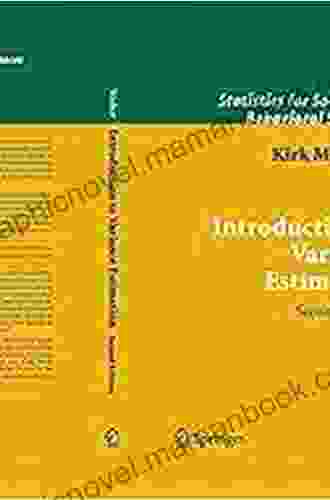Introduction to Variance Estimation Statistics for Social and Behavioral Sciences

Variance estimation is a critical component of statistical analysis in the social and behavioral sciences. It allows researchers to quantify the variability in their data and to make inferences about the population from which their sample was drawn. Variance estimation is also used to design sampling plans and to determine the sample size necessary to achieve a desired level of precision.
Types of Variance
There are two main types of variance: population variance and sample variance. Population variance is the variance of the entire population from which the sample was drawn. Sample variance is the variance of the sample itself.
5 out of 5
| Language | : | English |
| File size | : | 8246 KB |
| Screen Reader | : | Supported |
| Print length | : | 462 pages |
Population variance is usually unknown, but it can be estimated using the sample variance. The sample variance is an unbiased estimator of the population variance, meaning that it will, on average, produce an estimate that is equal to the true population variance.
Methods of Variance Estimation
There are a number of different methods that can be used to estimate variance, including:
- The method of moments
- The maximum likelihood method
- The Bayesian method
The method of moments is a simple method that is often used to estimate variance. It involves finding the values of the population parameters that minimize the sum of the squared differences between the observed data and the expected values under the model.
The maximum likelihood method is a more sophisticated method that is often used to estimate variance when the data are normally distributed. It involves finding the values of the population parameters that maximize the likelihood function.
The Bayesian method is a method that allows researchers to incorporate prior information into their estimation of variance. It involves specifying a prior distribution for the population parameters and then using the data to update the prior distribution to produce a posterior distribution.
Applications of Variance Estimation
Variance estimation has a wide range of applications in the social and behavioral sciences, including:
- Hypothesis testing
- Confidence interval estimation
- Power analysis
- Sampling design
Hypothesis testing is a statistical procedure that is used to test whether there is a significant difference between two or more groups. Variance estimation is used to calculate the standard error of the difference between the groups, which is then used to determine the p-value for the test.
Confidence interval estimation is a statistical procedure that is used to estimate the range of values within which the true population parameter is likely to fall. Variance estimation is used to calculate the width of the confidence interval, which is then used to determine the precision of the estimate.
Power analysis is a statistical procedure that is used to determine the sample size necessary to achieve a desired level of precision. Variance estimation is used to calculate the effect size, which is then used to determine the sample size.
Sampling design is the process of selecting a sample from a population. Variance estimation is used to determine the type of sampling method to use and the sample size necessary to achieve a desired level of precision.
Variance estimation is a critical component of statistical analysis in the social and behavioral sciences. It allows researchers to quantify the variability in their data, to make inferences about the population from which their sample was drawn, and to design sampling plans and determine the sample size necessary to achieve a desired level of precision.
5 out of 5
| Language | : | English |
| File size | : | 8246 KB |
| Screen Reader | : | Supported |
| Print length | : | 462 pages |
Do you want to contribute by writing guest posts on this blog?
Please contact us and send us a resume of previous articles that you have written.
 Top Book
Top Book Novel
Novel Fiction
Fiction Nonfiction
Nonfiction Literature
Literature Paperback
Paperback Hardcover
Hardcover E-book
E-book Audiobook
Audiobook Bestseller
Bestseller Classic
Classic Mystery
Mystery Thriller
Thriller Romance
Romance Fantasy
Fantasy Science Fiction
Science Fiction Biography
Biography Memoir
Memoir Autobiography
Autobiography Poetry
Poetry Drama
Drama Historical Fiction
Historical Fiction Self-help
Self-help Young Adult
Young Adult Childrens Books
Childrens Books Graphic Novel
Graphic Novel Anthology
Anthology Series
Series Encyclopedia
Encyclopedia Reference
Reference Guidebook
Guidebook Textbook
Textbook Workbook
Workbook Journal
Journal Diary
Diary Manuscript
Manuscript Folio
Folio Pulp Fiction
Pulp Fiction Short Stories
Short Stories Fairy Tales
Fairy Tales Fables
Fables Mythology
Mythology Philosophy
Philosophy Religion
Religion Spirituality
Spirituality Essays
Essays Critique
Critique Commentary
Commentary Glossary
Glossary Bibliography
Bibliography Index
Index Table of Contents
Table of Contents Preface
Preface Introduction
Introduction Foreword
Foreword Afterword
Afterword Appendices
Appendices Annotations
Annotations Footnotes
Footnotes Epilogue
Epilogue Prologue
Prologue Allison Butler
Allison Butler Andrew Lang
Andrew Lang Holly Black
Holly Black Jessica Johnson
Jessica Johnson Summer Rose
Summer Rose Mel Dunay
Mel Dunay Alicja Urbanowicz
Alicja Urbanowicz Ifbb Pro Jeff Christian
Ifbb Pro Jeff Christian Chijioke Oguaju
Chijioke Oguaju Glen Buckingham
Glen Buckingham Karen Glass
Karen Glass Rick Riordan
Rick Riordan S A Pratt
S A Pratt Gloria Byrd
Gloria Byrd G K Parks
G K Parks David J Griffiths
David J Griffiths Andrew Baltzegar
Andrew Baltzegar Samuel R Delany
Samuel R Delany Maclen Stanley
Maclen Stanley Lorri Nicholson
Lorri Nicholson
Light bulbAdvertise smarter! Our strategic ad space ensures maximum exposure. Reserve your spot today!

 Alexander BlairThe Ultimate Himalayan Guinea Pig Training Guide: Bonding, Socialization, and...
Alexander BlairThe Ultimate Himalayan Guinea Pig Training Guide: Bonding, Socialization, and... Arthur MasonFollow ·4.6k
Arthur MasonFollow ·4.6k Juan ButlerFollow ·18.9k
Juan ButlerFollow ·18.9k Jackson BlairFollow ·5.9k
Jackson BlairFollow ·5.9k Benjamin StoneFollow ·4.2k
Benjamin StoneFollow ·4.2k Ervin BellFollow ·12.3k
Ervin BellFollow ·12.3k Bret MitchellFollow ·7.1k
Bret MitchellFollow ·7.1k Gene PowellFollow ·12.6k
Gene PowellFollow ·12.6k Brody PowellFollow ·11.9k
Brody PowellFollow ·11.9k

 Rex Hayes
Rex HayesWorld of Dead Volume Issue: An In-Depth Analysis
The World of Dead volume issue...

 Nathan Reed
Nathan ReedHard Lessons Learned from ERP Rollouts: A Hivemind...
Enterprise...

 Fernando Bell
Fernando BellWith the Light, Vol. 1: Illuminating the Extraordinary...
The advent of parenthood is a...

 Wesley Reed
Wesley ReedNo Helping Hand: True Story of Deadly Waves
In December 2004,...

 Ruben Cox
Ruben CoxIntroduction to Electrodynamics by David Griffiths: A...
to Electrodynamics by...
5 out of 5
| Language | : | English |
| File size | : | 8246 KB |
| Screen Reader | : | Supported |
| Print length | : | 462 pages |












